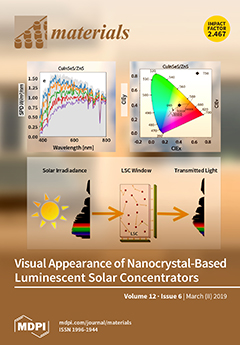Prefabricated building development increasingly requires foam concrete (FC) insulation panels with low dry density (
ρd), low thermal conductivity coefficient (
kc), and a certain compressive strength (
fcu). Here, the foam properties of a composite foaming
[...] Read more.
Prefabricated building development increasingly requires foam concrete (FC) insulation panels with low dry density (
ρd), low thermal conductivity coefficient (
kc), and a certain compressive strength (
fcu). Here, the foam properties of a composite foaming agent with different dilution ratios were studied first, high-belite sulphoaluminate cement (HBSC)-based FCs (HBFCs) with 16 groups of orthogonal mix proportions were subsequently fabricated by a pre-foaming method, and physical properties (
ρd,
fcu, and
kc) of the cured HBFC were characterized in tandem with microstructures. The optimum mix ratios for
ρd,
fcu, and
kc properties were obtained by the range analysis and variance analysis, and the final optimization verification and economic cost of HBFC was also carried out. Orthogonal results show that foam produced by the foaming agent at a dilution ratio of 1:30 can meet the requirements of foam properties for HBFC, with the 1 h bleeding volume, 1 h settling distance, foamability, and foam density being 65.1 ± 3.5 mL, 8.0 ± 0.4 mm, 27.9 ± 0.9 times, and 45.0 ± 1.4 kg/m
3, respectively. The increase of fly ash (FA) and foam dosage can effectively reduce the
kc of the cured HBFC, but also leads to the decrease of
fcu due to the increase in mean pore size and the connected pore amount, and the decline of pore uniformity and pore wall strength. When the dosage of FA, water, foam, and the naphthalene-based superplasticizer of the binder is 20 wt%, 0.50, 16.5 wt%, and 0.6 wt%, the cured HBFC with
ρd of 293.5 ± 4.9 kg/m
3,
fcu of 0.58 ± 0.02 MPa and
kc of 0.09234 ± 0.00142 W/m·k is achieved. In addition, the cost of HBFC is only 39.5 $/m
3, which is 5.2 $ lower than that of ordinary Portland cement (OPC)-based FC. If the surface of the optimized HBFC is further treated with water repellent, it will completely meet the requirements for a prefabricated ultra-light insulation panel.
Full article






